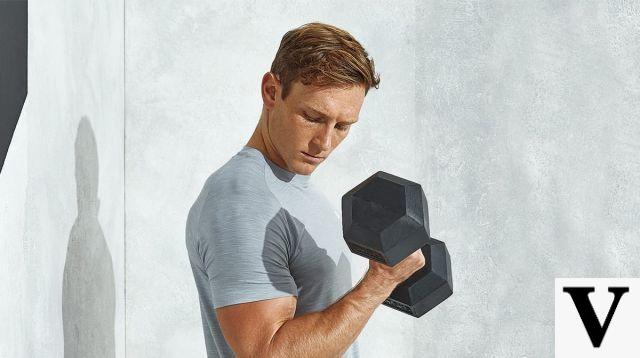L ‐ sit to Hand stand is a compound exercise of calisthenics, the term "compound" indicates that it is made up of several movements. As the name suggests, the first part consists of a L-sit followed by a transition of the body to move into a Handstand position; this is followed by another transition to return to the L-sit position.
The exercise in its most advanced version involves keeping the arms straight during the entire movement. The muscles most involved are those that move the shoulder joint in both flexion and extension.
The paravertebral muscles also have to work hard to extend the spine in the handstand position, and the abdominals work hard to maintain the L-sit.
From what has just been said it can be deduced that all the muscles of the upper body work in a single movement of medium-high intensity.
Preparatory
The best preparations for performing the final variation of this exercise are to start with the L-sit to Bent Arm Handstand and gradually work on a greater elbow extension.
This first variant involves starting from an L-sit position, if this is too difficult it is possible to start with a tucked L-sit or by maintaining the L-sit position but with the knees flexed.
The goal is to gradually increase the extension of the knees to full extension. From this position bring the knees to the chest, a momentum of the lower part of the body can be used to move into a bent arm hand stand position, always keeping the knees gathered on the torso.
Maintain this position for a few seconds and then check the eccentric phase until you reach a position where the trunk returns perpendicular to the floor. From here, extend the elbows and extend the shoulders back to the starting position.
The goal is to gradually gain strength in the concentric phase by exploiting the stimulus of the eccentric phase.
If you choose to try this exercise on the ground, you will quickly realize that a strong compression in the pelvis is required. In the first phase of this exercise it is useful to use steps as a support.
However, it is important that the height of the steps requires effort to keep the feet off the ground. This aspect is important because in this way the abdominals and above all the muscles that lower and protrude the shoulder are certainly involved.
These are the lower trapezius, the great dorsal, the small pectoral for depression while for protraction we refer to the great dentate.
Engaging these muscles means stabilizing the scapula and engaging the proximal muscles. These will be the muscles most involved in the final variation and it is therefore a good idea to train them right from the start.
In particular, lower trapezius and large dentate are very important muscles for the health of the scapula which directly affects the health and functionality of the shoulder.
Increase the compression
The compression of the pelvis is given by the flexibility of the muscles of the posterior kinetic chain and by the strength of those of the anterior kinetic chain. It is therefore necessary to have good elasticity in the hamstring muscles and to have good strength in the abdominals and hip flexors.
The strength of the abdominals provides a very wide active ROM, to acquire this it is possible to perform leg lifts while sitting with the knees extended while keeping the torso bent forward. work progressively on a higher ROM.
Increase strength with outstretched arms
Probably the hardest part is going from L-sit to Handstand position keeping your arms fully extended. This movement requires significant strength in the large dentate muscle, brachial biceps (especially the long head) and in the deltoid.
To make the best progress on this aspect it is useful to carry out a dedicated work. Start in the hand stand position about one step away from the wall.

The wall serves to be more efficient to position oneself in the Hand stand (not to fall forward). From here keep your elbows extended and bring your shoulders forward trying to control the
body fall as much as possible.
As soon as one begins to bring the trunk forward, it is necessary to bring the legs to the chest (keeping the knees extended); the movement represents an eccentric phase of the final movement only in a more isolated version.
Conclusion
The L-sit to Hand stand is an exercise that allows you to work almost all the muscles of the upper body. moreover, to be performed in the complete variant it requires good mobility and good strength in key muscles. Definitely an exercise to fit into your calisthenics goals.


























